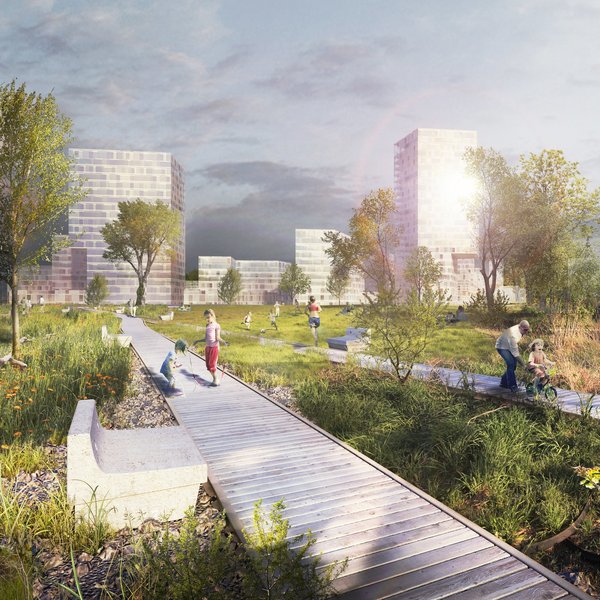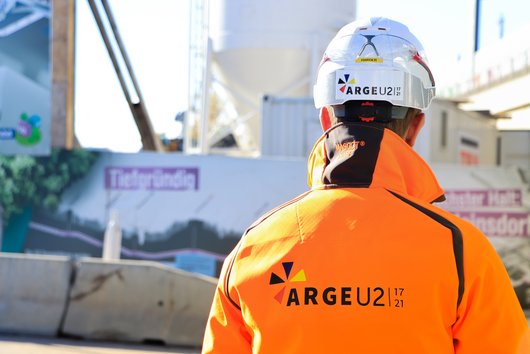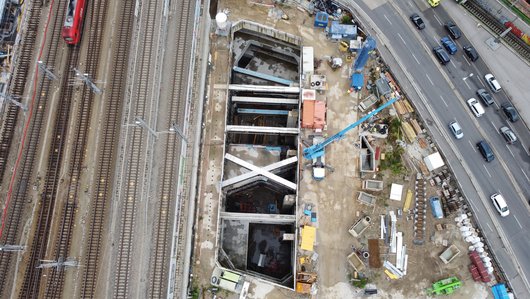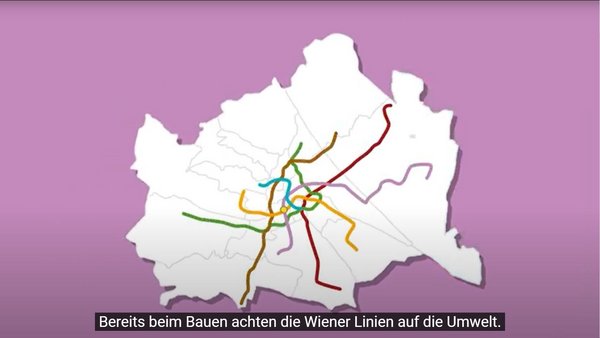
U2 in Vienna: When two giants become one
The wind buffets a grey sheet of cloud across the sky. It whistles through the equally grey urban canyons. The rain has just stopped falling; the grey streets are still wet. A mass of cars roars past us. You can hardly hear yourself speak. So, for ten minutes we walk side by side in silence. Until we reach a sign – with a logo that resembles a tunnel boring machine, or TBM. Next to it are the words “ARGE U2”. We continue along the gravel path until we reach the end. We find ourselves looking down at Matzleinsdorfer Platz. These grey surroundings are the setting for Vienna’s greenest project. This is where, starting in 2024, a TBM will burrow through the subsoil of the Austrian capital.
Turning around, we find a number of portacabins stacked side by side and on top of each other to form a well-equipped site office, including a kitchen with a large TV and a meeting room with a digital whiteboard. We are meeting the PORRians who are jointly responsible for the project: Harald Glösl, second technical managing director of Tunnel Construction, office manager Artur Herz, deputy project manager Peter Matulik of Railway Construction and Construction Engineering, and administrative project manager Christoph Emer. We are talking to them about the construction scheme and the cooperation between the office and the construction site, between different departments, and between two companies that are always perceived as competitors. We soon realise that there is only one team here, one community, one unit.
All aboard please
The U2/U5 line interchange is the City of Vienna’s largest climate protection project. When it is all completed, the new U2 will run from Wienerberg to the Urban Lakeside via Matzleinsdorfer Platz, Reinprechtsdorfer Strasse, Pilgramgasse, and Neubaugasse. The U5 will take you from Karlsplatz all the way to Hernals. This will increase the number of people who can use the Wiener Linien by a third, and will save a maximum of 75,000t of CO2 per year.
Public transport is more environmentally friendly than private transport – that much is clear. The U2 consortium proves that expanding public transport systems can also be very sustainable. For example, Wiener Linien stipulates the Euro 5 emission standard for all lorries, which are not even used as much as they could be. This is because most of the excavated material is transported through a central shaft to Matzleinsdorfer Platz, just off Triester Strasse, which in turn leads directly and quickly out of Vienna. This saves around 20,000 lorry journeys across the city and 75t of CO2. Furthermore: “The project we are implementing today was developed with the aim of protecting the environment. Five construction lots are interconnected, enabling continuous tunnelling with an electrically powered TBM. This also significantly reduces the traffic load,” explains deputy project manager Peter Matulik.
Next stop, the community
The U2 consortium is responsible for construction lots 17 to 21, which are combined into one project. Frequently seen as competitors, Austria’s largest construction companies are working shoulder to shoulder. PORR and STRABAG have established an internal joint venture to which they contribute equally in terms of staff, construction equipment, services, and decisions. Just as they both put in the same amount, they both get the same amount out. Everything is shared, fifty-fifty. “That’s why there are rarely arguments or discussions,” says Harald Glösl. “All the trades are working at the same time, which allows us to harness synergies – for example, when setting up the site facilities.”
So, is there no friction? “Sure, there is, especially at the beginning. You have to get people used to thinking along consortium lines. It’s a process. Distrust is anathema, that’s why it’s important to do everything transparently. We have regular discussions, which means we rely on good communication, and that works well,” explains the second technical director Glösl.
Another thing that helped was having their own logo featuring a stylised TBM. The colours are red and black for STRABAG, and blue and yellow for PORR. “We want to present ourselves as a community,” says Christoph Emer, commercial project manager. The consortium logo was also printed on work clothes, which were then handed out to the team. “More and more people are starting to wear it,” he says.


The companies PORR and STRABAG are visible everywhere you look – on banners, construction fences, and machines. Nevertheless, the shared logo brings people together. It transforms two companies into a single internal joint venture. It helps overcome differences that were never that large in the first place. “PORR and STRABAG aren’t that different in how they act and think,” says Peter Matulik. “There are more discussions between the various trades. Tunnellers from PORR and STRABAG usually get on well together. You are more likely to encounter differences of opinion between foundation engineers, civil engineers, and tunnellers from the same company.”
According to the deputy project manager, this is due to their different requirements, tasks, and needs. For example, tunnellers are used to working on the same construction site for several years. Special civil engineers, on the other hand, are hardly ever on the same project for more than two or three months. They work different hours, their accommodation varies – some live in a portacabin village, others in a boarding house, and a few are lucky enough to have a flat nearby. So, there is plenty of fuel for disagreement. “You have to talk to people, reach out to them, and explain why something is the way it is. No matter how different their requirements are, you have to treat everyone the same,” says Artur Herz. “After all, we spend several years on this project,” adds Harald Glösl, “so it’s important to get along.”
Next stop, the digital transformation
Cooperation with STRABAG is of course very close: “We hardly ever have only PORRians sitting here in the meeting room like we do today,” says Matulik. The cooperation between the construction site and the office is also very close. However, Gösl says, “We are the interface between headquarters and the construction site.” Everything is channelled through us, i.e. through one or two people. This allows everyone to work as independently as possible.” It’s the same at STRABAG.
Speaking of cooperation: most of it is digital. “We can learn a lot from each other,” says Artur Herz. Of course, LEAN plays an important role, too. In addition, BIM is to be used for construction lot 20. Meetings are held via Microsoft Teams. “This would be necessary even without Covid-19. There are more than 50 of us at times, soon there will be more than 70. If we didn’t have a digital solution, we would have to set up a tent for every meeting,” says Matulik and laughs. Then there is a dedicated app that instantly saves construction site documentation photos to a shared platform.
The huge map of the construction site that Artur Herz pins to the board in the meeting room will no doubt soon be available digitally as well – including the plan that shows which works are being performed when and where. At present, the U2 consortium’s special civil engineering team is digging down into the depths of Reinprechtsdorfer Strasse, Pilgramgasse, and Neubaugasse, where the stations will be.


“They have a larger diameter than the tubes to accommodate the platforms and other factors. That’s why we use both: cyclical tunnelling with excavators and jetcrete in the stations and emergency exits, and continuous tunnelling with the TBM, which is then driven through the stations,” explains Peter Matulik. Once the tunnel boring machine has arrived at its destination, Augustinplatz, it will be brought up to the surface and transported back to Matzleinsdorfer Platz, from where it will dig the second, western tube. We decided to take a closer look at this construction site.
Next stop, the launch shaft
The wind has dispersed the sheet of cloud. The sun bathes the grey surroundings in a warm and friendly light. It does not, however, reach far into the huge, 35m-deep shaft into which, following a safety briefing, we are led by Daniel Harder from the occupational safety department. It is noon, the lunch break is drawing to a close. For just a moment, we are alone in the vast depths. Silence. With our eyes wide and our mouths open, we stand and look around. This is the starting point for boring the southern tube, which will commence in 2024 and for which preparatory work is now underway. This includes, for example, the boreholes that are needed to freeze the ground. Particular caution is required at this critical point: the railway runs over the tracks under which the TBM will dig its way for the first few metres. It is the main ÖBB railway route to the west and south.
Suddenly we hear footsteps. The workers are returning. They meet us on the stairs. All at once, the construction site erupts into life. The silence is shattered by the sounds of drilling. We head back to the surface.


Please disembark
We thank the team and say our goodbyes. My mind is humming with everything I have seen today as I head home – on foot. The journey would take me more than 20 minutes by public transport. For now. In a couple of years’ time, I’ll get on the U2 here and remember being on this construction site. I’ll remember what it looked like. This neighbourhood, so grey and noisy today, will blossom and flourish thanks to the excellent new connections. Then, not five minutes later, I will be roused from my reverie by the underground announcement: Please disembark.
The project at a glance
- Project type: Special Civil Engineering, Construction Engineering, Tunnel Construction, Railway Construction
- Project scope: Construction of a new underground railway with a route length of approx. 3km, 4.3km of TBM tunnelling, and 2.2km of NATM tunnelling, 4 station buildings and 3 emergency exits with ventilation shafts, track construction, various building upgrades
- Employer: Wiener Linien GmbH & Co KG
- Contractor: U2 consortium consisting of PORR Bau GmbH and STRABAG AG (50/50)
- Project period: February 2021 to mid-2028


![[Translate to Englisch:] (c) PORR A modern, light-flooded room. One of the men is wearing virtual reality glasses and looking upwards.](/fileadmin/_processed_/e/7/csm_BIM_BMW_VR_Brille_Modell_Digital_02_72dpi_1ba9a9e852.jpg)
![[Translate to Englisch:] (c) Jvan Tresch [Translate to Englisch:] (c) Jvan Tresch](/fileadmin/_processed_/c/b/csm_Chalchschijen_MG_6744__4__21149fd843.jpg)